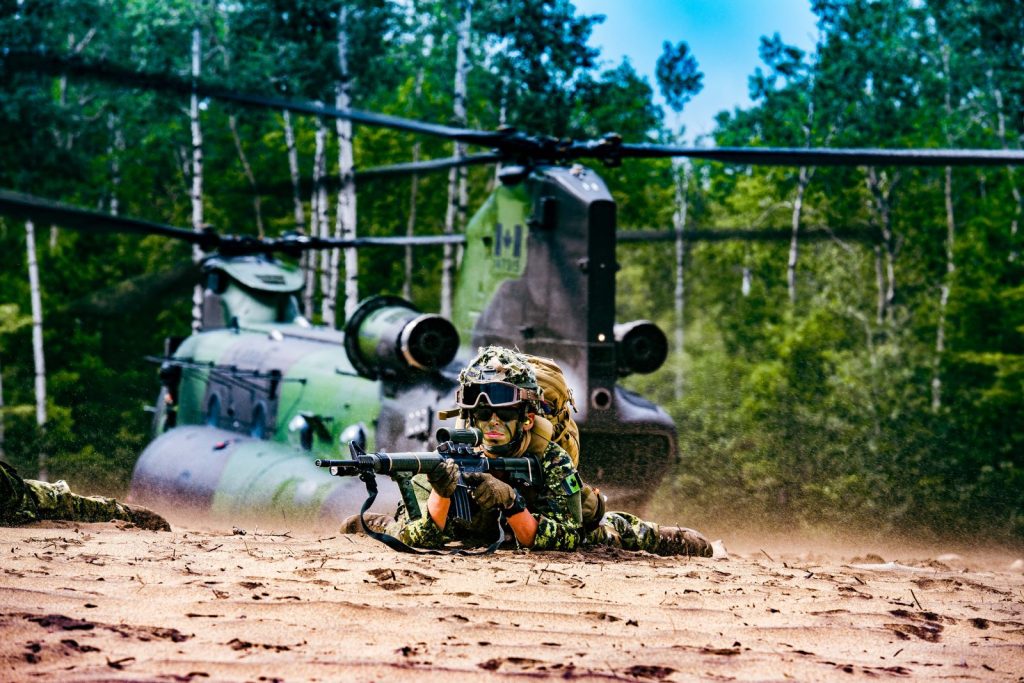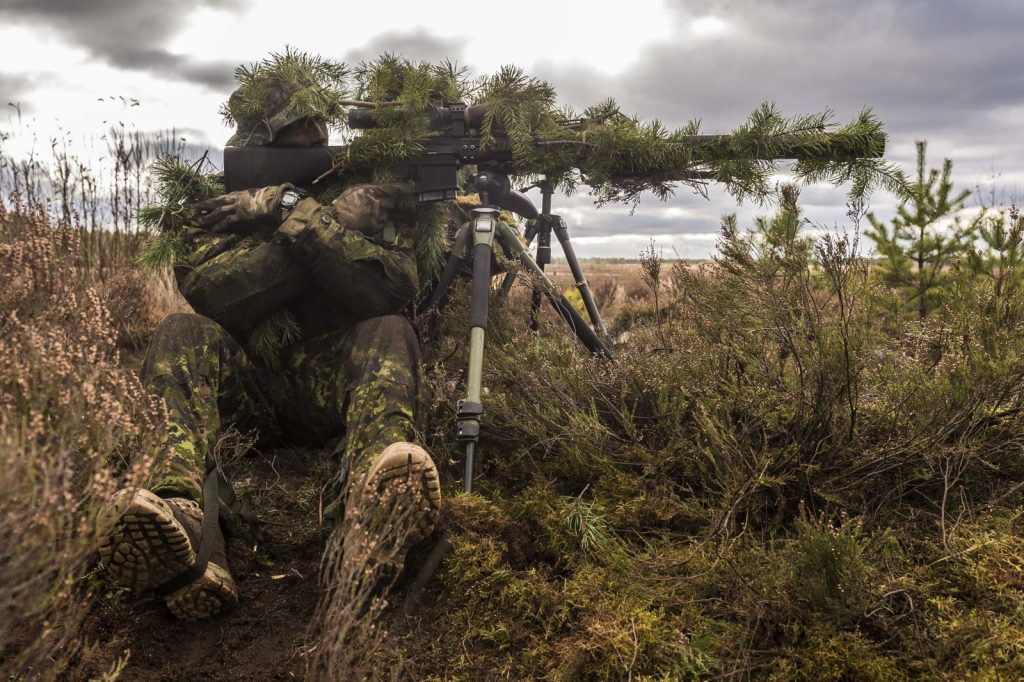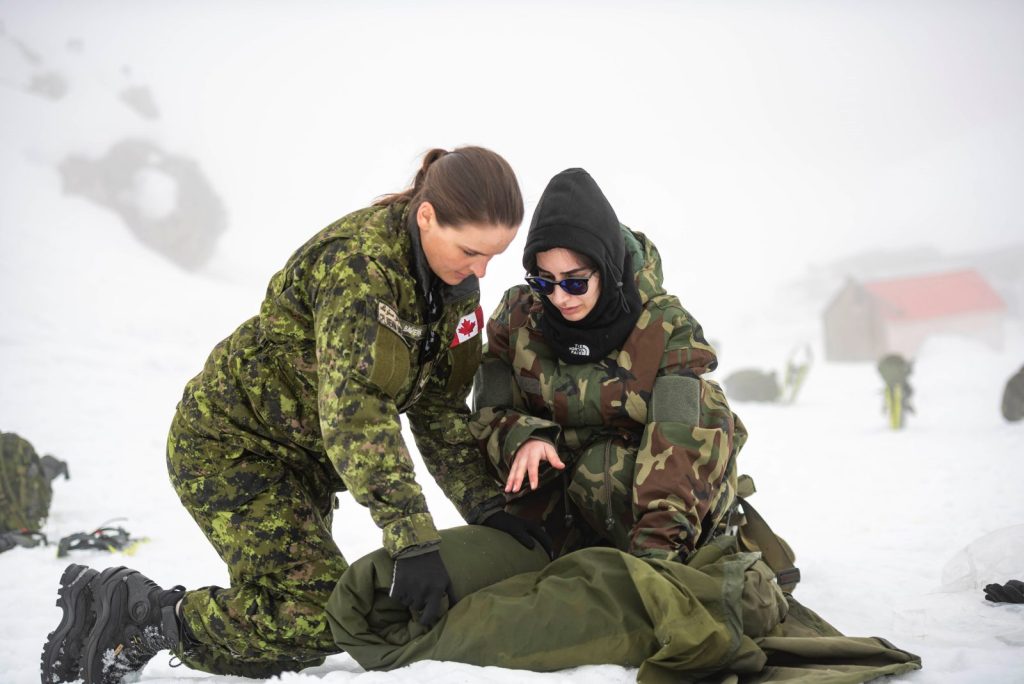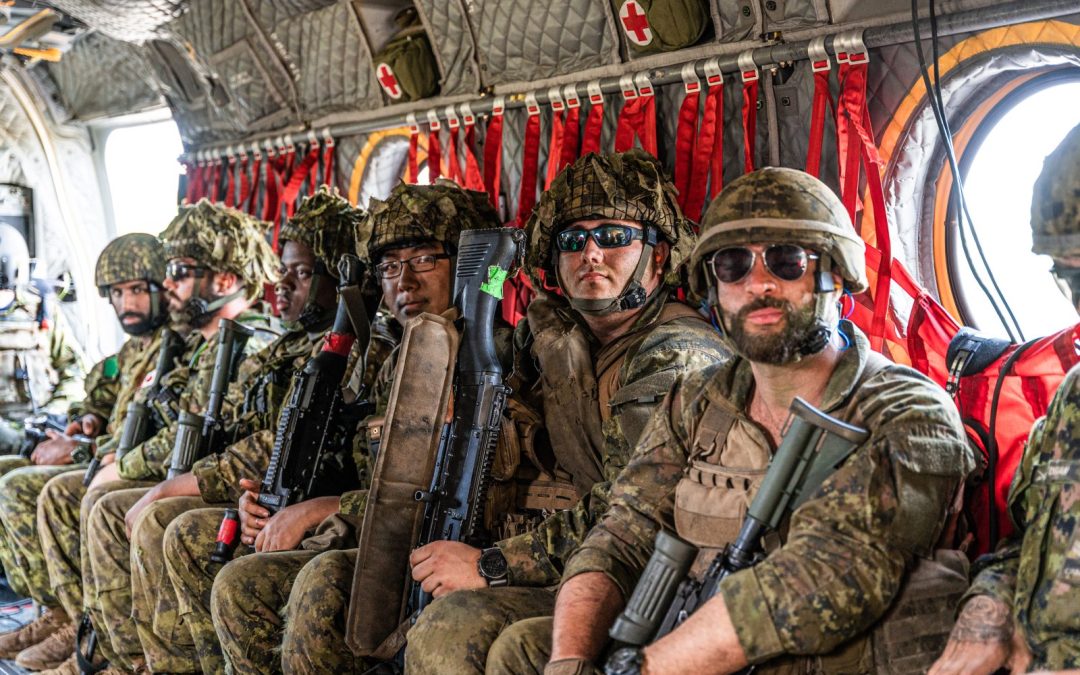Facing a workforce crisis, the military is starting to see positive effects from a multi-pronged plan to recruit and retain talent.
by Lisa Gordon
Last fall, Chief of the Defence Staff General Wayne Eyre acknowledged that the Canadian military is facing a workforce crisis. In a directive issued on Oct. 6, 2022, he said significant work must be done to “overcome deficiencies that are hampering the composition and readiness of the Canadian Armed Forces (CAF).”
Changing demographics, the aftermath of the Covid-19 pandemic, and “unhealthy attrition” are some of the factors influencing the CAF’s ability to promote and defend Canada’s interests — at home and abroad.
In his directive for CAF Reconstitution, Eyre said efforts to recover and rebuild the Canadian Army, Royal Canadian Navy and Royal Canadian Air Force will focus on three priorities: people, operations, and modernization. He ordered that all non-essential tasks, ceremonies and other events be cancelled or minimized in order to prioritize reconstitution efforts.
What do these reconstitution efforts look like, and what progress is being made? Canadian Army Today spoke with two senior officers, Major-General Lise Bourgon, Acting Commander, Military Personnel Command, and Brigadier-General Krista Brodie, Commander of Military Personnel Generation Group, about member retention and recruitment – two crucial aspects of returning the CAF to full strength.

A member of 33 Canadian Brigade Group watches his arcs after getting off of a CH-147F Chinook from 450 Tactical Helicopter Squadron during Ex Saltwar Wolf in August 2022. Photo: S1 Anne-Marie Brisson
RETENTION: NO SILVER SOLUTION
The 2022 CAF Retention Strategy, also issued on Oct. 6, 2022, aims to improve the military experience for all members in the Regular Force and Reserve Force. Initiatives will focus on enhancing personal well-being and improving workplace culture and work-life balance. Taken together, these programs aim to retain CAF members who take their unique skills, knowledge and training with them when they choose to leave military service before reaching compulsory retirement age.
Across the CAF, the average rate of attrition (Regular Force and Primary Reserve) is generally between eight and nine percent. This is the lowest attrition in the Five Eyes intelligence alliance (where Canada’s partners include Australia, New Zealand, the United States and the U.K.), but it is still concerning.
The CAF says its desired strength level is 71,500 Regular Force members and 30,000 average paid strength (APS) for the Primary Reserve. That would allow the forces to deliver and sustain concurrent operations in keeping with government priorities and objectives, both domestically and internationally. However, the Regular Force and Primary Reserve are currently well under these desired strength levels. The Regular Force has 63,453 members (a decrease from 65,024 at the beginning of this fiscal year), while the Primary Reserve sits at an APS of 22,047 (a decrease from 22,799 at the beginning of the fiscal year).
While accepting that natural attrition is unavoidable as members retire to make way for the next generation, CAF leaders are particularly focused on reducing what is called “unhealthy attrition.”
“Unhealthy attrition, which is really the target of the retention strategy, is looking at these people that leave before completing basic training,” explained Bourgon. “They leave before reaching the operationally functional point where they’re employable.”
In addition, unhealthy attrition includes more prevalent departures in certain employment equity groups, or within specific occupations and trades where people are leaving at a higher rate than elsewhere.
Bourgon said the overall CAF attrition rate of eight to nine percent can be further divided into medical releases and “unhealthy” voluntary releases — although those categories are not mutually exclusive. Over time, the CAF’s new exit surveys will offer more information related to the experiences of CAF members and the factors influencing retention. Currently, attrition numbers are not available specifically for the Army.
“Members leave for different reasons,” she continued. “We do surveys regularly to get information on why people leave the CAF. . . My gut feeling from all the town halls I’ve done in the last year is that the reasons people leave are agnostic to the uniform that they wear.”
The most recent surveys pointed to job and pay dissatisfaction, linked back to the post-pandemic increased cost of living. But other than a non-specific desire for change, the biggest reason CAF members give for leaving is the impact of the military lifestyle on their spouse and children.
“There is a desire for a bit more stability and control of where they get sent and employed. So, those are the biggest reasons that we are tracking.”
While she acknowledged there is no one magic solution to fix the retention issues, the CAF must truly understand why people leave the service to then implement solutions to address those pain points, Bourgon said. Key to that effort will be new exit surveys designed to identify exactly what is prompting members to depart.
“If you tell me that you’re leaving for family reasons, that doesn’t give me enough to go and push for different programs,” she explained. “If I hear the majority of men and women saying, ‘I am leaving the CAF because I don’t have access to daycare,’ as an example, then we can go back to the government and say, ‘People are leaving because they don’t have access to daycare. Therefore, daycare is super important. We need to do something about this.’”
Bourgon acknowledged that it’s currently an employee market, and the CAF is facing competition from the civilian world, which may offer higher pay. She believes one of the ways to counter this threat is by better communicating the “CAF Offer” – in other words, that being a member is about more than getting a paycheque.
“It’s key for everyone to understand that being a CAF member is about more than getting a salary deposited into your bank account . . . there is also the non-monetary aspect of being a CAF member: the pension plan, the access to the gym, the leave, all the education and the training, the uniform, the esprit and the camaraderie.
“We forget about the rest of the package, the total reward that we get in the CAF . . . that is so incredible and we have to measure that value proposition. People need to be aware of that package, so they completely understand what they’re getting at the end of the month.”
In addition to better communicating what the CAF can offer, Bourgon said the retention strategy includes placing good leaders in the chain of command.
“People don’t leave the military because of a specific problem. They usually leave because it’s the last drop. [They feel] that their leadership, their chain of command, is not getting involved, is not supporting them.”
As part of its culture evolution, the CAF is placing an emphasis on inclusion initiatives and will be training and selecting leaders who can walk that talk. “People need to feel valued, appreciated, cared for – that’s for everyone, that feeling of belonging . . . how we select and how we evaluate our leaders is very, very important,” she said.
The CAF Retention Strategy is part of a larger multi-pronged approach designed to attract more people to military service. In 2022, for example, the CAF updated its dress code to be more inclusive by allowing members to have longer hair, beards and tattoos, among other changes.
Bourgon said Canada’s Five Eyes allies are watching the dress code changes closely to see if it will make a positive difference in recruitment and retention. She said international programs have also inspired Canadian initiatives, including the CAF Offer. “Again, [it’s about] feeling valued and being who you are, and being able to be who you are in uniform.”
When it comes to retaining CAF members, Bourgon said that at the end of the day, positive progress can be measured in improved morale, greater trust in the institution, and a reduction in unhealthy attrition.
“I would say that the troops are going to tell us if we’re making progress,” she concluded. “Normally, they’re not shy to tell us what we need to change. So, it’s about listening to them and trying to execute on their dissatisfiers.”

A sniper successfully completes a stalking exercise during Exercise Iron Sword at General Silvestras Žukausas Training Area in Pabradė, Lithuania. Photo: Cpl Nathan Moulton
RECRUITMENT: CAUTIOUSLY OPTIMISTIC
The CAF Common Operating Picture is a report that tracks a wide variety of monthly statistics, including member intakes/releases, recruiting and training levels, occupations with critical staffing issues, and reconstitution plans.
Numbers from Dec. 31, 2022, reveal that the total strength of the CAF’s Regular Force was 63,453 members. That’s 8,089 short of the total establishment number (71,542) authorized by the government and Treasury Board Secretariat in terms of positions and pay. What’s more, that shortfall has been growing steadily since 2020.
Along with retention, recruiting plays a critical role in meeting the CAF’s broader reconstitution goals.
“In any given year, our Horizon 1 Strategic Intake goal will rest somewhere between 6,300 and 6,800,” explained Brodie.
“We know that for 2022-23, our goal was just over the 6,300 threshold. But, we knew right off the bat at this time last year, before we even started, that we were not going to be able to achieve that. We have a really good appreciation of what our capacity is from a recruiting and training perspective . . . the barrier this year was recruiting capacity and so our goal was set at 5,900 . . . even knowing that what we really needed was 6,300 [to satisfy reconstitution numbers].”
Brodie said the Covid-19 pandemic had a massive impact on the CAF’s training capabilities.
“We went through a couple of years where we had the capacity to process and bring in more than we could actually train. That paradigm shifted this year; all of a sudden, our governor is recruiting capacity, that initial onboarding capacity.”
As of late January, Brodie said the CAF had reached 55 percent of its in-year strategic intake goal, with just over 3,200 of the 5,900 enrolled. She said that when fourth quarter capacity is considered, the CAF expectation (as of Feb. 17) is that it will achieve 67 percent of its intake, or 4,000 members.
It’s been a dynamic time, with record recruitment in the fourth quarter of last year, represented by January to March 2022. The CAF enrolled 1,000 members in January 2022 alone — numbers not seen since the height of the Afghanistan mobilization. But Brodie said that came at a cost: any qualified applicants waiting for an offer received one, and the recruit wait list was depleted. This has caused the CAF to quite literally recruit off the street in real time to meet training starts.
“It became very clear within the first several weeks of the new production year and certainly by the end of April (2022) . . . that we were in an applicant crisis,” she said.
The CAF responded by increasing its advertising and being more present at targeted community attractions and activities, elevating Canadians’ awareness about military careers. By October 2022, applicant numbers were starting to trend in the right direction. On Nov. 1, the CAF “opened the aperture” further by accepting applications from Permanent Residents, and by the end of the month, the forces had received more than 6,000 applications. Brodie said the positive trend continued into December and January.
“There is scope for us to be cautiously optimistic that many of these micro improvements that we’re accruing are having a positive impact,” she said.

Cpl Brenna Baverstock of the Winter Mobile Training Team helps soldiers of the Lebanon Border Regiment (LBR) with their gear in the Bcharre region, Lebanon, in February 2020. Photo: Cpl Nicolas Alonso
Within the Army, it’s the technical trades that are suffering the most in terms of personnel shortages. These include occupations in the communications and signals space as well as vehicle technicians.
Brodie said that having those technical domains fully staffed is key to being operationally effective in a digitally-enabled battlefield. She said targeted recruiting will focus on communicating the CAF value proposition to “places where people have and are studying for and demonstrating interest in those fields.”
Broadly speaking, the CAF intends to dial up awareness about its career options, which extend far beyond traditional combat positions. It is also streamlining the application process thanks to the implementation of new digital architecture, and speeding up medical approvals for applicants who do not require further examination. Security checks for 85 percent of Canadian citizen files are going through within 14 days, while onboarding time for permanent residents is slower.
Brodie said from a culture standpoint, the CAF is a large and complex organization of more than 100,000 people. It has committed to holding itself publicly accountable for tearing down archaic biases and adopting a more open and welcoming culture — one that allows people to be themselves as they serve.
Word of mouth is by far the most effective CAF recruitment tool, and Brodie said current or former members serve a valuable role when they act as CAF ambassadors. The Canadian Forces Recruiting Group has launched a resource that provides information for CAF members to pass along to interested members of the public. Social media also plays a huge role in keeping the military top of mind with Canadians.
Brodie summed up the plan to reconstitute the CAF: “To return to full strength we must attract suitable applicants in sufficient numbers; onboard them through an optimized experience from a human and digital perspective; and provide a training experience that optimizes their potential to perform in their designated occupation, so they feel they are valued members of the organization — and we need to do that over and over again at scale.”
In a world where threats are evolving and the operational environment is always changing, CAF reconstitution will not be a short-term undertaking.
As various retention and recruitment efforts begin to converge, the military hopes to see member satisfaction rise while unhealthy attrition declines, as new applicants come forward to renew the CAF’s fighting spirit.


Leadership dropped the ball big time in thinking that allowing long hair, any tattoos and scruffy uniforms would help retain/attract members. These are an integral part of self discipline. I can assure you that allowing long hair – other than for indigenous people – makes no difference at all, other than making our armed forces look silly.
“[The CAF] has committed to holding itself publicly accountable for tearing down archaic biases and adopting a more open and welcoming culture — one that allows people to be themselves as they serve.”
Interesting that the concept of the ‘team’ – a collective to which the individual belongs and owes loyalty – is not reflected in these remarks. Why?
In the effort to recruit more Gen Z-ers, has the pendulum swung too far toward individualism? Or is the CAF hoping that the team concept will be absorbed (and embraced) by new members through some form of osmosis?
I, fully agree with above comments. As a retired CAF member, myself and looking at the Canadian Forces that I joined back in the late 70’s. Then comparing todays CAF with the new way forward and the CAF I joined. Well, there is defiantly no comparison in any way, shape or form from then to now.
When I first looked at joining the CAF. I looked at the CAF members themselves at that time as having esprit de corps, comradeship, professionalism, a pride in oneself, pride in their uniform, pride in the CAF as a whole and a pride in Canada.
The new way forward of the long hair, scruffy beards, earing’s worn anywhere on the face, tattoos up the neck including the face and head, the sloppy ill maintained uniforms, the list goes on. Let’s face it. It does not project
professionalism or a pride in oneself or pride in the CAF.
Today. I see that the individualized that was mentioned below and how the new way forward is being represented by our CAF members to Canadians and the world. And. Its not very impressive.
Members have to remember that they are representing the CAF in Canada and on the world stage as its Military Fighting Force.
Personally, today if I were looking at joining the CAF and seeing the new way forward of CAF members and their “individualism”. I would most likely just walk right on by the Recruiting Office.
I support the new recruitment approach but fear it will be to little, too late, to support emerging strategic demands. As a ‘unhealthy attrition’ statistic myself (many years ago) I believe it is important for veterans and serving members of all ranks to have broader and richer relationships with new recruits, especially those most likely to be unhealthy attrition. Cloistering themselves behind hierarchy and tradition is not in the national interest.
Scott, hierarchy is essential to military command structure. The military defends democracy, it does not exist to practice it.
Tradition is essential to esprit de core and is an important facet of learning and education.
These two factors alone are essential to the national interest.
I cannot apologize for what I cannot control, but as a former RCAF instructor I note that not all who attempt military life succeed.